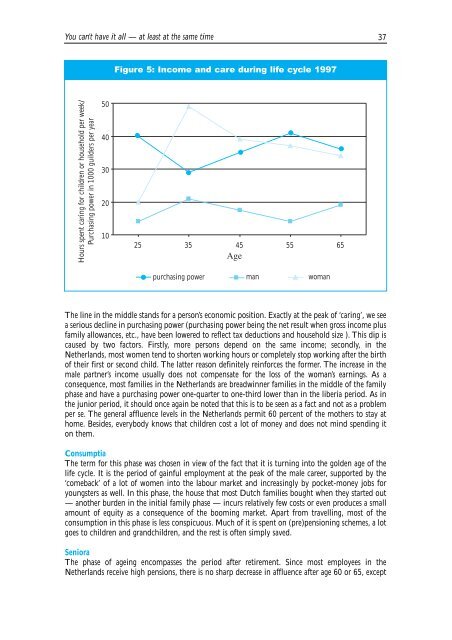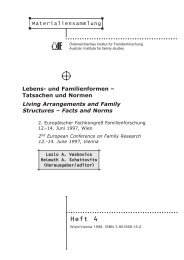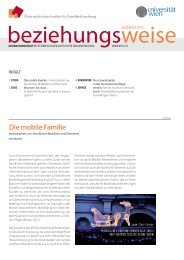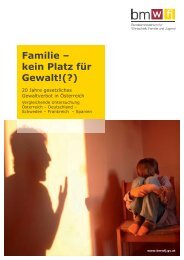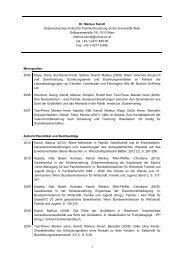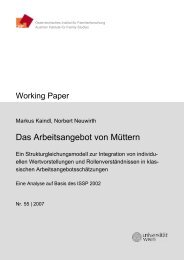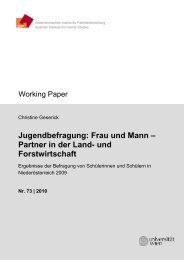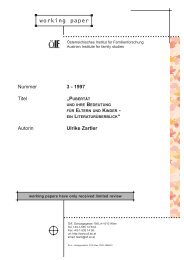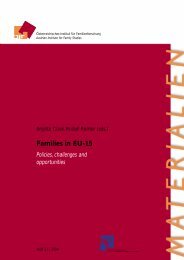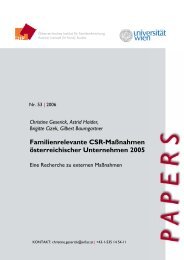Family issues between gender and generations
Family issues between gender and generations
Family issues between gender and generations
Create successful ePaper yourself
Turn your PDF publications into a flip-book with our unique Google optimized e-Paper software.
You can’t have it all — at least at the same time<br />
37<br />
Figure 5: Income <strong>and</strong> care during life cycle 1997<br />
Hours spent caring for children or household per week/<br />
Purchasing power in 1000 guilders per year<br />
50<br />
40<br />
30<br />
20<br />
10<br />
25 35 45 55 65<br />
Age<br />
purchasing power<br />
man<br />
woman<br />
The line in the middle st<strong>and</strong>s for a person’s economic position. Exactly at the peak of ‘caring’, we see<br />
a serious decline in purchasing power (purchasing power being the net result when gross income plus<br />
family allowances, etc., have been lowered to reflect tax deductions <strong>and</strong> household size ). This dip is<br />
caused by two factors. Firstly, more persons depend on the same income; secondly, in the<br />
Netherl<strong>and</strong>s, most women tend to shorten working hours or completely stop working after the birth<br />
of their first or second child. The latter reason definitely reinforces the former. The increase in the<br />
male partner’s income usually does not compensate for the loss of the woman’s earnings. As a<br />
consequence, most families in the Netherl<strong>and</strong>s are breadwinner families in the middle of the family<br />
phase <strong>and</strong> have a purchasing power one-quarter to one-third lower than in the liberia period. As in<br />
the junior period, it should once again be noted that this is to be seen as a fact <strong>and</strong> not as a problem<br />
per se. The general affluence levels in the Netherl<strong>and</strong>s permit 60 percent of the mothers to stay at<br />
home. Besides, everybody knows that children cost a lot of money <strong>and</strong> does not mind spending it<br />
on them.<br />
Consumptia<br />
The term for this phase was chosen in view of the fact that it is turning into the golden age of the<br />
life cycle. It is the period of gainful employment at the peak of the male career, supported by the<br />
‘comeback’ of a lot of women into the labour market <strong>and</strong> increasingly by pocket-money jobs for<br />
youngsters as well. In this phase, the house that most Dutch families bought when they started out<br />
— another burden in the initial family phase — incurs relatively few costs or even produces a small<br />
amount of equity as a consequence of the booming market. Apart from travelling, most of the<br />
consumption in this phase is less conspicuous. Much of it is spent on (pre)pensioning schemes, a lot<br />
goes to children <strong>and</strong> gr<strong>and</strong>children, <strong>and</strong> the rest is often simply saved.<br />
Seniora<br />
The phase of ageing encompasses the period after retirement. Since most employees in the<br />
Netherl<strong>and</strong>s receive high pensions, there is no sharp decrease in affluence after age 60 or 65, except


